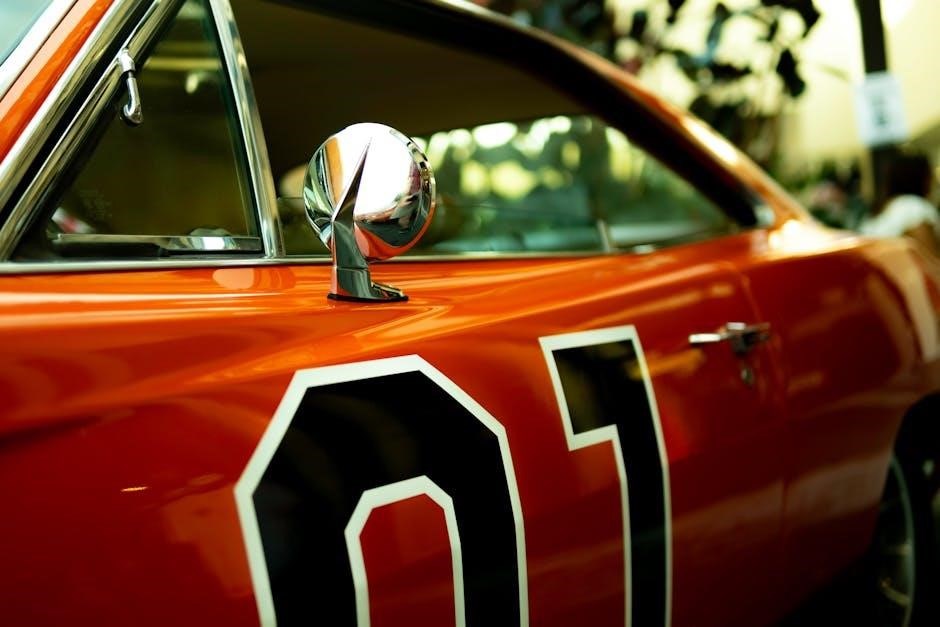The Chevrolet 4-speed manual transmission is a legendary component, known for its durability and performance in classic Chevrolet vehicles. It became iconic in muscle cars like the Camaro and Corvette, offering precise control and thrilling driving experiences. Enthusiasts praise its mechanical simplicity and direct connection to the road, making it a symbol of automotive heritage and a favorite among restorers and collectors. Its impact on Chevrolet’s history is undeniable, solidifying its place in the hearts of car enthusiasts worldwide.
1.1 Historical Overview
The Chevrolet 4-speed manual transmission has a rich history, tracing back to the late 1950s when manual transmissions became integral to performance vehicles. Initially designed for durability and precision, it gained prominence in Chevrolet’s iconic muscle cars, such as the Camaro and Corvette. By the 1960s, the 4-speed became synonymous with driving enthusiasts, offering a direct connection to the road. Over the years, it evolved to meet growing performance demands, with the Muncie transmission emerging as a standout design. However, by the early 1980s, the rise of automatic transmissions led to its decline. Despite this, the Chevrolet 4-speed remains a beloved relic, cherished by collectors and restorers for its mechanical simplicity and historical significance in automotive culture.
1.2 Evolution in Chevrolet Vehicles
The Chevrolet 4-speed manual transmission evolved significantly over its lifespan, adapting to the performance demands of various Chevrolet models. Initially introduced in the late 1950s, it quickly became a staple in Chevrolet’s lineup, particularly in high-performance vehicles like the Camaro and Corvette. Throughout the 1960s and 1970s, the 4-speed underwent refinements, including improved gear ratios and stronger components, to handle increased horsepower and torque from Chevrolet’s big-block engines. The Muncie 4-speed, a celebrated variant, became synonymous with durability and precision. By the 1980s, however, the rise of automatic transmissions led to its gradual decline. Despite this, the Chevrolet 4-speed remains a defining feature of classic American muscle cars, embodying the spirit of driving enthusiasts who value manual control and authentic performance.

Key Features and Components
The Chevrolet 4-speed manual transmission is renowned for its durability, precise gear engagement, and robust mechanical design. Key components include a synchronized gear system, a sturdy gearbox, and a driver-friendly clutch mechanism, making it a favorite among enthusiasts for its reliability and performance capabilities.
2.1 Gear Ratios and Performance
The Chevrolet 4-speed manual transmission is celebrated for its versatile gear ratios, which were optimized for both performance and drivability. Common gear ratios included 2.54:1 for first gear, 1.89:1 for second, 1.47:1 for third, and 1:1 for fourth, providing smooth acceleration and responsive shifting. These ratios were tailored to enhance the driving experience, whether on the street or the track. The transmission’s design allowed for precise control, making it a favorite among drivers who valued a direct connection to their vehicle. The close-ratio setups in performance models further emphasized its capability for spirited driving, while wide-ratio options offered better highway cruising. This balance of performance and practicality made the 4-speed a standout in Chevrolet’s lineup, appealing to both enthusiasts and everyday drivers alike.
2.2 Muncie Transmission: A Legendary Design
The Muncie 4-speed manual transmission, produced by General Motors, is a iconic component in Chevrolet’s history. Known for its strength and reliability, the Muncie was widely used in Chevrolet’s performance-oriented vehicles, such as the Camaro and Chevelle. Its robust design featured a cast-iron case and a synchronized gear system, making it durable and capable of handling high horsepower. The Muncie transmission became synonymous with American muscle cars, offering precise shifting and a direct driving experience. Its popularity among enthusiasts has endured, with many seeking out Muncie-equipped models for restoration projects. The transmission’s legendary status is a testament to its engineering excellence and its role in Chevrolet’s rich automotive heritage.
2.3 Clutch System and Mechanism
The clutch system in Chevrolet’s 4-speed manual transmission plays a crucial role in smooth gear transitions. It consists of a pressure plate, clutch disc, and release bearing, working together to engage and disengage the engine from the transmission. The clutch disc is typically made of friction material for durability, while the pressure plate applies consistent force. When the driver presses the clutch pedal, it activates the release bearing, disengaging the engine. This mechanism allows for precise control during shifting. Over time, wear on the clutch disc or release bearing can lead to slippage or difficulty engaging gears. Proper maintenance, such as adjusting the clutch pedal free play and inspecting for wear, is essential to ensure optimal performance. The clutch system’s reliability and responsiveness have made it a favorite among driving enthusiasts.

Popular Models Equipped with the 4-Speed Manual
The Chevrolet 4-speed manual transmission was famously paired with iconic models like the Camaro, Corvette, and Chevelle. These cars became symbols of performance and driving enthusiasts’ passion.
3.1 Chevrolet Camaro
The Chevrolet Camaro, introduced in 1966, became a hallmark of American muscle cars, with the 4-speed manual transmission playing a pivotal role in its performance legacy. The Camaro’s pairing with the 4-speed manual allowed drivers to experience precise control and exhilarating acceleration, making it a favorite among driving enthusiasts. This combination was particularly popular in the first-generation models, where the manual gearbox complemented the powerful V8 engines. The Camaro’s reputation as a performance icon was further cemented by its availability with the 4-speed, which became synonymous with the car’s identity during the muscle car era. Today, restored Camaros with the original 4-speed transmission remain highly sought after by collectors and enthusiasts, celebrating both the car’s heritage and the timeless appeal of manual driving.
3.2 Chevrolet Corvette
The Chevrolet Corvette, America’s iconic sports car, was famously paired with the 4-speed manual transmission, enhancing its reputation as a high-performance vehicle. The 4-speed manual became a defining feature of the Corvette, particularly in the 1950s and 1960s, when it was matched with powerful engines like the 283 cubic-inch V8. This combination delivered exceptional acceleration and control, making the Corvette a symbol of driving excellence. Enthusiasts cherished the direct connection and precision offered by the manual gearbox, which amplified the car’s dynamic capabilities. The Corvette’s association with the 4-speed manual transmission remains a celebrated chapter in its storied history, embodying the spirit of classic American motoring and continuing to inspire admiration among car enthusiasts worldwide.
3.3 Chevrolet Chevelle
The Chevrolet Chevelle, a mid-size marvel, showcased the 4-speed manual transmission in its high-performance SS models, offering drivers a sporty and engaging experience. Paired with robust engines like the 396 cubic-inch V8, this setup became synonymous with power and precision, making the Chevelle a standout in its class. Enthusiasts cherished the direct control and exhilarating feel it provided, enhancing the car’s appeal. As a key player in the muscle car era, the Chevelle, equipped with the 4-speed manual, became a beloved classic, blending style and performance seamlessly. This combination not only highlighted Chevrolet’s engineering prowess but also solidified the Chevelle’s legacy as a favorite among driving enthusiasts, embodying the spirit of a bygone era in automotive history.

Maintenance and Repair
Regular fluid checks and lubrication are essential for smooth operation. Common issues include worn synchros and bearings. DIY repairs can save costs, but complex fixes often require professional expertise.
4.1 Fluid and Lubrication Requirements
Proper lubrication is essential for the longevity and smooth operation of the Chevrolet 4-speed manual transmission. The transmission requires a high-quality gear oil with the appropriate viscosity to ensure optimal performance. It is recommended to use a GL-4 rated gear oil, as it is specifically designed for manual transmissions and provides excellent wear protection for gears and bearings. Fluid changes should be performed every 30,000 to 50,000 miles, depending on driving conditions. Avoid using automatic transmission fluid (ATF), as it can damage the transmission’s internal components. Regular inspection of the fluid level and condition is crucial to prevent premature wear. Always refer to the owner’s manual or consult a professional mechanic for specific recommendations tailored to your vehicle’s needs.
4.2 Common Issues and Troubleshooting
The Chevrolet 4-speed manual transmission, while durable, can experience common issues such as worn synchronizers, leading to difficulty shifting gears. A growling or grinding noise during operation often indicates a faulty input shaft bearing. Transmission leaks, typically from worn seals or gaskets, can occur over time. Additionally, improper lubrication or using the wrong fluid type may cause premature wear on internal components. Troubleshooting involves checking fluid levels, inspecting for leaks, and listening for unusual noises. If issues persist, consulting a professional mechanic is recommended to avoid further damage. Regular maintenance and prompt repairs can extend the transmission’s lifespan and ensure smooth performance.
4.3 DIY Repair vs. Professional Service
DIY repair of the Chevrolet 4-speed manual transmission can be cost-effective for minor issues like fluid changes or clutch adjustments, provided the owner has mechanical skills and tools. However, complex repairs, such as rebuilding the transmission or replacing internal components, often require professional expertise. Amateur attempts at major overhauls can lead to further damage or unsafe operation. Professional mechanics have the specialized tools and experience to ensure precise adjustments and reliable results. For enthusiasts, a balanced approach is recommended: handle routine maintenance and simple fixes independently, but seek professional help for critical or intricate repairs to maintain the transmission’s performance and longevity.

Legacy and Collector Value
The Chevrolet 4-speed manual transmission holds iconic status, sought by classic car enthusiasts for its historical significance and emotional connection to legendary muscle cars. Its lasting appeal as a testament to Chevrolet’s engineering heritage ensures high collector value, particularly in restored models like the Camaro and Corvette, where it embodies the spirit of driving purism and mechanical simplicity cherished by purists.
5.1 Why Enthusiasts Love the 4-Speed
Enthusiasts adore the Chevrolet 4-speed manual transmission for its mechanical simplicity, direct driver engagement, and nostalgic appeal. Its presence in iconic models like the Camaro and Corvette cemented its reputation as a symbol of performance and authenticity. The transmission’s durability and reliability make it a favorite among classic car restorers, while its precise gear control delivers a thrilling driving experience. Many cherish the emotional connection it provides, evoking memories of a bygone era in automotive history. Its timeless design and enduring functionality ensure its place in the hearts of collectors and driving purists alike, making it a cornerstone of Chevrolet’s legacy.
5.2 Restoration Tips and Tricks
Restoring a Chevrolet 4-speed manual transmission requires meticulous attention to detail and the use of genuine GM parts for authenticity. Start by thoroughly inspecting the transmission case and components for wear or damage. Replace the input shaft bearing if grinding noises are present, as this is a common issue. Ensure proper lubrication using GM-specified fluids to maintain smooth operation. Refurbish or replace the clutch system, including the pressure plate and throwout bearing, for optimal performance. Consult original Chevrolet service manuals for precise specifications and procedures. For complex tasks, consider seeking expertise from professional transmission builders. Finally, protect your restoration with a high-quality chrome finish or durable coating to preserve its condition for years to come.